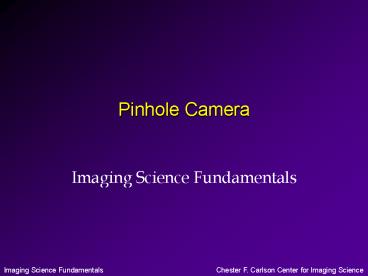Pinhole Camera PowerPoint PPT Presentation
1 / 12
Title: Pinhole Camera
1
Pinhole Camera
- Imaging Science Fundamentals
2
Light
Ultraviolet Rays
Infrared (IR)
Gamma Rays
Radio wave
Microwave
X Rays
Light
750 nm
400 nm
Wavelength
- People detect visible wavelengths as colors
since the human eye is sensitive to that
particular wavelength range.
3
Simple imaging system Medical Xray
X Ray source
Film
Object
Image
- X-rays either penetrate the object being imaged
and are then detected by film, or they are
absorbed. Result is a shadowgram.
- What if we replaced the x-ray source with a
visible light source?
4
Typical imaging chain for pinhole camera
Visible light source
Film (capture)
pinhole
processing
Object
Image
Dark box
5
Light from a Point Source
- A point source is a source in which the light
appears to be emanating from one point in space. - A point source casts energy in all directions,
shown above as rays. - A star can be considered a point source. (Why?)
6
Point Source Casting Rays
Object
- Take a look at 7 of the rays cast from one
position (the tip) of the object. - With no collection element, all of these rays
fall on the image plane. There is no way to
determine the source of the rays.
7
Three Points on the Object
- This becomes a problem when three points on the
object are considered. - The energy can be collected at the image plane,
but all information about the object is lost.
8
Need for Collection Element
- A crucial element in most imaging systems is the
component responsible for collecting the energy
emerging from a given point on the object, such
that it is brought to a single point in the image.
9
Ideal Pinhole Camera
An ideal pinhole allows only a single ray from
each point on the object to pass through. This
preserves the spatial distribution of energy,
creating a sharp image. An ideal pinhole camera
has an infinitely small aperture (opening).
10
Problems with Ideal Pinhole Camera
- An infinitely small aperture allows an infinitely
small amount of light (zero) to pass through. - Diffraction (which is ignored in geometric
optics) blurs the image when the pinhole is very
small.
11
Realistic Pinhole Camera
Since the pinhole cannot be infinitely small,
more than one ray actually gets through, blurring
the image formed at the image plane.
12
Capture
- The image can now be captured using a detection
system, such as photographic film. - Film must be processed to yield a permanent,
visible image.
13
Image Capture - Photographic Film
- Film consists of a photosensitive compound known
as Silver Halide (AgX), which reacts with light. - The area exposed to light turns dark after
processing. - The total amount of light hitting a given area of
film (known as exposure) determines how dark that
area turns.
14
Limitations of Pinhole Camera
- Finite pinhole size and diffraction degrade final
image. - Light collection is poor - aperture must be small
- so image acquisition is slow.

